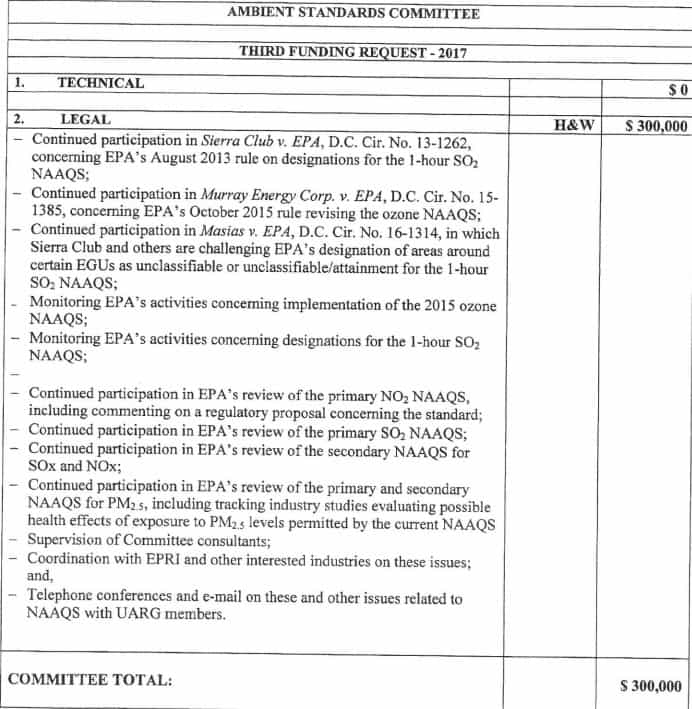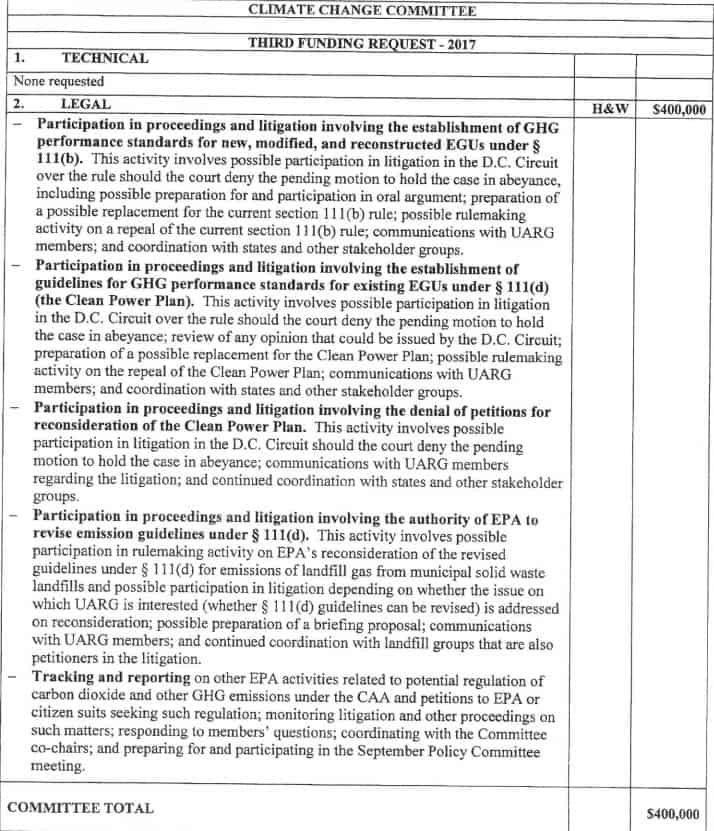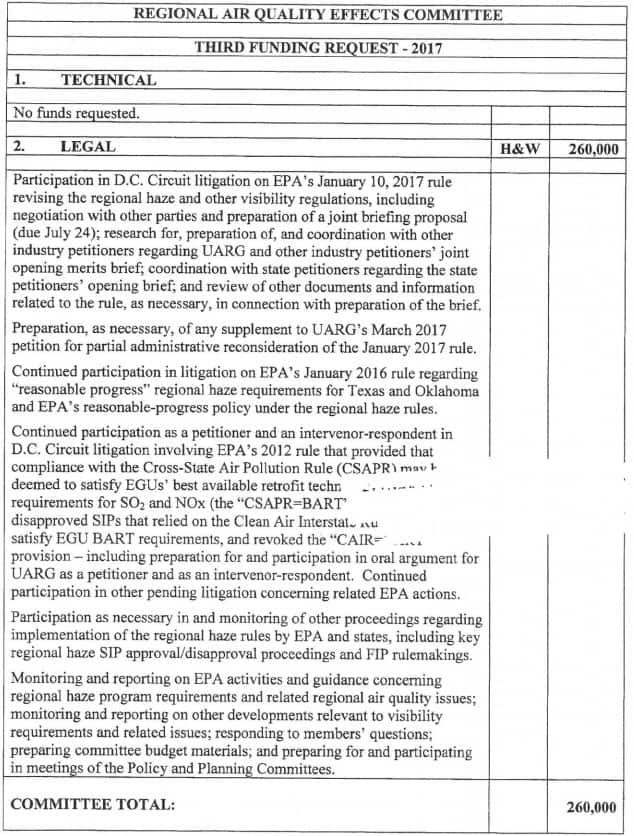
Utility Air Regulatory Group (UARG)
The Utility Air Regulatory Group (UARG) was a little known but influential group that fought EPA Clean Air Act rules. UARG disbanded amid Congressional oversight investigations in 2019. The group described itself as “a not-for-profit association of individual generating companies and national trade associations that participates on behalf of its members collectively…”
The firm that represented UARG, Hunton Andrews Kurth (formerly Hunton & Williams) failed to divulge precisely which of the nation’s electric utilities it represented when it sued the EPA.
“They are the dark matter of the electric energy industry, and one shouldn’t really be able to take on the government’s efforts to curb climate change or mercury pollution and do it anonymously,” David Doniger, director of the Natural Resources Defense Council’s Climate and Clean Air Program, told S&P Global. “This is a way of having the law firm do their dirty work without taking any...
The Utility Air Regulatory Group (UARG) was a little known but influential group that fought EPA Clean Air Act rules. UARG disbanded amid Congressional oversight investigations in 2019. The group described itself as “a not-for-profit association of individual generating companies and national trade associations that participates on behalf of its members collectively…”
The firm that represented UARG, Hunton Andrews Kurth (formerly Hunton & Williams) failed to divulge precisely which of the nation’s electric utilities it represented when it sued the EPA.
“They are the dark matter of the electric energy industry, and one shouldn’t really be able to take on the government’s efforts to curb climate change or mercury pollution and do it anonymously,” David Doniger, director of the Natural Resources Defense Council’s Climate and Clean Air Program, told S&P Global. “This is a way of having the law firm do their dirty work without taking any responsibility for it in public discourse.”
A statement submitted by Hunton & Williams attorney George C. Freeman Jr. to the EPA on behalf of UARG in 1978 reveals that UARG formed after the 1977 amendments to the Clean Air Act.
Since 2001, UARG been a party in about 200 lawsuits that challenged federal clean air regulations since. Some of these lawsuits have been prominent cases that went to the U.S. Supreme Court.
UARG won a 2014 U.S. Supreme Court ruling in Utility Air Regulatory Group v. EPA, in which the justices determined that the EPA overstepped its authority in regulating any source of greenhouse gas emissions, though the ruling reaffirmed EPA’s authority to regulate global warming emissions from power plants.
In an earlier landmark case, Massachusetts v. EPA, states and cities sued the George W. Bush administration’s EPA to force the agency to regulate greenhouse gas emissions. UARG filed petitions and briefs to defend the Bush EPA and argued that the issue did not merit a review by the U.S. Supreme Court. The Court disagreed, and in 2017, ruled 5-4 in favor of the states. The ruling paved the way for the current EPA proposals to limit greenhouse gas emissions from power plants.
UARG was also active in coordinating its members’ legal response to the Obama administration’s Clean Power Plan proposal, which has since been repealed and replaced by President Trump’s Affordable Clean Energy rule.
UARG praised the Trump rule while environmental groups and academic studies have pointed out how the proposal does little to limit carbon dioxide emissions, and could even increase other kinds of pollution, like sulfur dioxide and nitrogen oxide, from coal plants.
Before an S&P 2016 investigation into UARG that detailed members and how it operates “outside the public domain”, only a 2006 document attached to regulatory comments filed to the EPA shed light on the members of UARG. At the time, 43 utility corporations and four trade associations were members of UARG.
Documents obtained and published by Politico in February 2019 further revealed UARG’s actions and membership. The materials outlined goals for a meeting of the group’s policy committee to attack Obama-era clean air and public health rules.




The documents also revealed all of the 2017 UARG members and the amount each company contributed that year.
According to InsideEPA($), a utility industry source said one major complaint among the members in UARG was that it lacks a litigation advisory committee and would unilaterally pursue suits that the source describes as “litigation run amok.”
Utility ratepayers paying for UARG dues
In April 2019, leading Democrats on the House Energy and Commerce Committee sent letters to several utility CEOs asking for information pertaining to former UARG attorney and EPA official Bill Wehrum’s relationship with the group and its member companies.
Ameren, American Electric Power, DTE Energy, Vistra Energy, Southern Company, FirstEnergy, Tri-State Generation and Transmission Association, and the Tennessee Valley Authority are the companies that received letters.
The Congressional letters also requested that the utilities state whether their UARG annual contributions come from customers or shareholders.
“This is about transparency. Ratepayers have a right to know if they’re involuntarily paying for a secret campaign to undermine critical public health protections,” Rep. Pallone told Politico ($).
The Energy and Policy Institute detailed in its 2017 report Paying For Utility Politics how several utilities across the country have attempted to force their customers to pay for UARG and other trade association annual dues in rate cases at public utility commissions. And in 2016, Jonathan Levenshus, a leader of the Sierra Club Beyond Coal Campaign, raised concerns about Tennessee Valley Authority’s funding of UARG before the TVA board. He recently told the Times Free Press:
“As a corporate agency of the federal government, TVA should not be involved with an entity that regularly sues the federal government … For decades, UARG’s work has resulted in numerous lawsuits to delay, roll back, or block environmental and public health laws affecting the electric power industry. It’s time for TVA to own up to UARG’s record of trying to prolong air pollution from power plants and leave this organization once and for all.”
Both the Minnesota and Kentucky Offices of Attorneys General have argued that UARG expenses be charged to shareholders because the group engages in advocacy efforts.
In the last Arizona Public Service rate case, the Arizona Residential Utility Consumer Office asked that shareholders cover UARG expenses. The RUCO office said UARG is “purely voluntary … political in nature, and may not be necessary for the provision of utility services.”
Missouri Public Service Commission Staff stated in an Ameren rate case that “It is Staff’s position that the primary purpose of these groups is to address environmental regulation on behalf of the utility industry, whose interests do not necessarily align with those of ratepayers.”
“It is upsetting to think that you’re paying for a utility to lobby for what’s not in their customers’ interest,” said John Coffman, a lawyer and utilities expert representing the Consumers Council of Missouri told the St. Louis Post-Dispatch. “(UARG) is a group that environmental groups would be at odds with.”
On April 30, American Electric Power confirmed to the members of Congress that their ratepayers foot the bill for its membership in UARG. AEP customers paid $555,395 in 2017 for their power company to be in Hunton Andrews Kurth group.
Utility members
After members of Congress began their investigation into Wehrum and UARG, many utility companies quickly announced that they had quit the group: Arizona Public Service, Consumers Energy, DTE Energy, Dominion, Duke, Eversource, Kansas City Power & Light, Minnesota Power, NiSource, South Carolina Electric & Gas (merged with Dominion), and We Energies. In total, these ten utility companies made up 35% of UARG’s 2017 budget.
InsideEPA($) reported on the financial pressure UARG now faces: “Who is going to make up for all that money? These guys have been on the gravy train for a long time,” the source told the outlet. The “frustration is very high” among some utility members of UARG, which has never been “short on arrogance.”
Before dissolution, the remaining companies and trade associations in UARG were:
-
- Southern Company
-
- American Electric Power
-
- Tennessee Valley Authority
-
- Vistra (formerly Dynegy)
-
- Luminant
-
- FirstEnergy
-
- Louisville Gas & Electric/Kentucky Utilities (PPL Corporation)
-
- Ameren
-
- Salt River Project
-
- Oglethorpe Power
-
- Tucson Electric Power (UNS Energy)
-
- Tri-State Generation and Transmission
-
- Ohio Valley Electric Company (whose owners are FirstEnergy, Buckeye Power, AES Corporation, PPL Corporation, American Electric Power, Wolverine Power, and Vectren)
-
- Wabash Valley Power
-
- Otter Tail Power
-
- Edison Electric Institute
-
- National Rural Electric Cooperative Association
-
- American Coalition for Clean Coal Electricity
-
- American Public Power Association (APPA)
-
- National Mining Association
Featured Articles


Utilities, once represented by UARG, now part of the ‘Electric Generators for a Sensible Transition’ in their suit against the EPA

Virginia bill would bar utilities from charging customers for politics, joining other states

